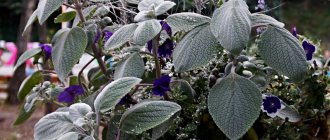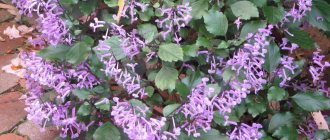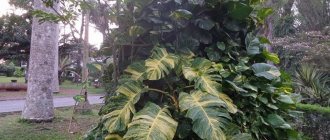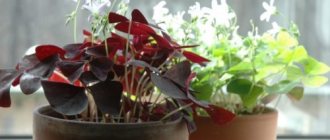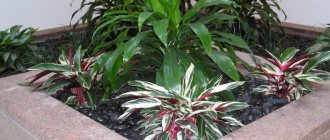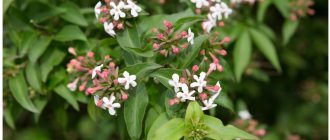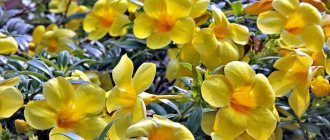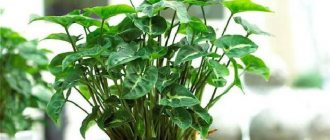Recently, a friend sent me a photo of a flower that she was given as a gift called “room mint” and was recommended to make tea from it. I immediately guessed the plant; it turned out to be my favorite plectranthus. Having started to study information about the plant in more detail, I found out that plectratus is not only a spectacular ampel. They actually make fragrant tea from it. They are also used to treat many diseases, to fight moths and even to attract money! Read more about plectranthus, or spur flower, in this article.
Indoor mint: video of a candidate of agricultural sciences on how to care for plectranthus (read more) Plectranthus - beautiful, fragrant and healthy.
What is plectranthus?
Plectranthus is a semi-succulent perennial with a woody base and grows as an evergreen in the south. Plectranthus has characteristic thick fluffy leaves with a strong pleasant smell; they can be round, heart-shaped or triangular in shape, with jagged, wavy edges. The flowers are in two-lipped spikes or panicles and can be white, pink or lavender. The height of the plant varies greatly depending on the species - from 15 cm to 1 m or more, many species spread along the ground or grow like ampels.
In the middle zone, indoor mint is grown as a heat-loving annual or indoor flower. Primarily valued for its attractive foliage. Plectranthus is an excellent addition to arrangements of colorful annuals. Cuttings can also be planted directly in a flower bed, as the plant grows quickly.
Note! Sometimes plectrnathus is confused with ivy leaf, especially with its variegated form. But budra has smaller leaves and they feel less dense and not at all as juicy as those of plectranthus. The stems of the budra are thin and drooping.
Pest and disease control
Plectranthus has good immunity, so it almost never gets sick. But with high humidity and low temperatures, even he suffers from fungal diseases. In this case, it is necessary to treat the bush with fungicides and adjust the regime. Affected shoots will have to be removed immediately.
The persistent aroma of plectranthus repels pests. It is very rare to see aphids, mites or scale insects on it. It is usually sufficient to gently wash the leaves with soapy water. If there are a lot of insects, use protective drugs!
Photo: missouribotanicalgarden.org
Epipremnum (50 photos): types, cultivation and care at home
Plectranthus coleus
Plectranthus coleoides Marginatus, Plectranthus forsteri) is one of the most popular plant species that can often be found in urban landscaping. In particular, I first encountered it when I saw a magnificent composition in the phytodesign of a cafe. This variegated plectranthus grew in the company of bright red geraniums, which looked stunningly impressive. Later I managed to find out what kind of plant it was and purchased its cuttings. Plectranthus coleus is a small bush up to 25-30 cm high and 50-60 cm wide with green serrated leaves with a maximum length of about 4 cm.
Plectranthus forsteri, variation "Marginatus".
The most popular in decorative floriculture is the variegated variation of Plectranthus Forster “Marginatus”, or “Variegatus” . This is a very bushy plant with bright green jagged leaves beautifully edged with a creamy stripe. In autumn, the plant may bloom with small lavender or white flowers. Stems and leaves are sparsely pubescent, with long and short hairs. When grown in a container, the weight of the leaves causes the shoots to droop, which is why this plant is popular as an ampel.
As for the smell, this type of plectranthus has perhaps the most intense one, most often described as camphorous, but personally I feel that this plant smells of incense. Different people's attitudes towards this scent may differ. But personally (although the smell is harsh) it has a calming effect on me.
What problems might there be and how to solve them
Despite the subtropical origin of plectranthus, difficulties when growing it in our climate do not often arise, but it is necessary to familiarize yourself with them in order to eliminate care errors in a timely manner and obtain healthy plants.
| Problems | Causes | Solutions |
| Leaves turn yellow and dry out, roots rot | Low air temperature or excessive watering | The optimal air temperature in summer is approximately +20 – 22°C, in winter – +15°C. reduce watering intensity |
| Leaves wither, stems droop | Insufficient watering, dry air | Carry out urgent watering and spraying, after which the plant can be covered with a bag |
| Leaves fade and become discolored | Exposure to direct sunlight | Shade the plant, move it to a place with diffused light |
Plectranthus silver
Silver plectranthus (Plectranthus argentatus) is valued for its attractive, fluffy grey-green foliage that appears to be covered in frost. Most often, we grow its varietal variation “ Silver Shield”. This cultivar is more compact than the species plant and usually grows up to 30 cm in height and up to 60 cm in width. The leaves are ovate, pointed, gray-green with a combed edge, covered with dense silvery pubescence. The stems are erect, but in hanging baskets the bush grows as a hanging bush. Tubular, bluish-white flowers are collected in spike-shaped inflorescences and bloom in mid-summer.
Silver plectranthus (Plectranthus argentatus).
This hybrid can be easily grown from seeds sown indoors 4-6 weeks before the intended planting in a permanent location. I grew silver plectranthus from seeds. The process of growing plectranthus seedlings does not present any difficulties, and its cultivation is similar to sowing coleus. Plants from seeds develop very quickly and reach their peak decorative value by mid-summer, having time to bloom. The mother plant can be brought into the house for the winter, grown as a houseplant, and cut in the spring.
I really liked combining silver plectranthus with beautifully flowering plants with cool-colored petals, for example, purple petunias, blue brachycoma, blue ageratum and others. Plectranthus looks especially impressive hanging from a hanging basket. The aroma of this plectranthus is also similar to incense or camphor, but slightly weaker than that of the coleus.
Botanical description
The indoor flower plectranthus, or indoor mint, is a herbaceous perennial plant or evergreen shrub 60-80 cm high with a fibrous root system and branched shoots, creeping or growing vertically. The stem of Plectranthus domestica is ribbed, slightly pubescent, covered with red-brown or bright green skin. The oppositely arranged aromatic leaves, oval or ovoid in shape with fine teeth along the edge, can be bare or densely pubescent, and the leaf blade is covered with a relief of veins or a variegated pattern. Indoor mint plectranthus blooms in summer with short, dense apical panicles of bisexual white, lilac, purple or blue flowers. Ripe fruits containing four nuts open on their own.
Plectranthus blushes
Plectranthus purpuratus is an erect, spreading plant with dark green, fleshy leaves that are distinguished by a purple tint on the reverse side; the stems can also be purple. Against the green background of the foliage, the beet-colored veins look very decorative; the young leaves are almost entirely purple, so the bushes look multicolored. The shape of the leaves is slightly rounded and jagged.
Plectranthus purpuratus.
Blooming Plectranthus ruddens.
Inflorescences appear on the tips of the shoots - this is a spike 30-120 mm long, often with two lateral branches. The flowers are tiny, two-lipped, white to bluish speckled. In indoor conditions, this type of plectranthus blooms from September to May. The height of the bush does not exceed 30 centimeters; in pots it also behaves like an ampel.
Not only is it a showy houseplant, it is ideal for rockeries, containers or as a ground cover for shade. I first became acquainted with this plant when I saw it in a flowerbed near a flower shop, where it formed a dense mat that looked very unusual, since this type of plectranthus is very rarely used as a flowerbed plant.
For me, plectranthus turned out to be a wonderful hanging plant for balcony boxes, where it formed a magnificent duet with petunias and pethoa in warm sunny shades (yellow, orange, ivory). Unlike other types of plectranthus, this is one of the most compact species and does not take up too much space in the pot.
When I bring the mother plants in for the winter, they give me their pretty blooms in October, their speckled flowers reminiscent of tiny orchids, and the white petals against the burgundy foliage looking especially attractive. Believe it or not, this plectranthus smells like basil. But its aroma is weaker than that of other species.
Plectranthus blooming
Flowering plectranthus (Plectranthus neochilus) is a low ground cover plant with velvety, pubescent foliage. The leaf blade is bluish-green due to pubescence. “ Dwarf Variegated” with a light wide leaf border is more common The leaves are medium-sized, rounded with slightly jagged edges. These are low bushes, usually they do not exceed 25 cm, and they grow a little slower than other species.
Flowering plectranthus (Plectranthus neochilus).
This variety of spur flower is distinguished by the longest attractive flowering, since its spike-shaped inflorescence is denser and denser and consists of bright blue two-lipped flowers. In its homeland and in the southern regions, the flowering spur flower is in bloom for a long time, almost all year round. Attractive spikelets rise above the carpet of variegated leaves to a height of 15 cm and look very impressive, slightly reminiscent of the flowering of creeping tenacious.
Most often this species is used as a ground cover, but it can also be used as an hanging plant. Although, in my experience, flowering plectranthus does not grow so quickly and does not form a very long ampel from cuttings over the summer. On my balcony, this interesting, delicate plant looked very good in hanging baskets in combination with pastel-colored annuals, such as pink petunia and bacopa. In the plant’s homeland, it is believed that the flowering plectranthus, with its strong and pungent odor, scares away snakes from people’s homes. The smell of this type of plectranthus is almost identical to bitter wormwood.
Reproduction
The plectranthus flower has an unpretentiousness and unusual appearance. Therefore, it can be found in many private collections and botanical gardens. Varieties can be propagated in two ways - cuttings and dividing the bush.
You can use both options at home. If you follow the technology, it is easy to get new specimens of your plants.
Cuttings
The easiest and most affordable way to propagate plectranthus mint is by cuttings. For him, it is enough to cut a shoot at least 10 cm long. He must be strong and healthy. It is better to tear off the lower leaves.
The cutting is placed in a glass of water and placed in a shaded place. The roots appear in 2-3 weeks. After this, the plectranus is planted in a small pot and standard conditions are organized.
Plectranthus of different types can be rooted in another way. For this, the cuttings are immediately planted in the ground and the pot is covered with a glass jar. The soil is kept moist. The appearance of roots can be determined by the development of new leaves.
Dividing the bush
Another propagation method that is convenient to carry out during transplantation is dividing the bush. To do this, carefully remove the mint plant from the pot and clean the roots from the soil. After this, the flower is slowly divided into several bushes.
Important! The shoots and roots are carefully separated so as not to damage them.
The plectranthus plant tolerates this procedure well. The plots are planted in different pots and standard conditions for growth are created.
Seeds
There is another propagation option - through seeds. But it cannot be used at home. After flowering, you need to pollinate the flowers and wait for the formation of fruits that will contain seeds.
It is optimal to propagate plectranthus by cuttings or by dividing the bush. These two methods are reliable and deserve the attention of both beginners and experienced gardeners.
Healing plectranthus aromatic
Plectranthus tea is usually brewed from only one species of spur flower, Plectranthus aromatica. Although it does not have such an attractive and even quite ordinary appearance, compared to its decorative counterparts, this plant is famous for its medicinal properties, and also has some other uses in everyday life.
Plectranthus amboinicus is distributed mainly in Tropical Africa, Asia and Australia. This is a perennial plant with thick, succulent tetrahedral stems of brown or green color and fleshy green leaves of a round shape with a wavy edge. It grows in the form of branched, spreading bushes from 50 to 100 cm in height. Sometimes this plant is also called “cubano oregano” because its smell is very reminiscent of the spice oregano (oregano).
Plectranthus amboinicus (Plectranthus amboinicus).
As a medicine, plectranthus aromatica is used to treat a wide range of diseases. A decoction of the leaves is primarily used for respiratory diseases accompanied by nasal congestion, bronchitis, and sore throat. It also helps with diseases of the digestive system (dysentery, diarrhea, colitis, etc.). It is believed that fragrant plectranthus can be effective in urolithiasis, and also has antiepileptic, antitumor and antimicrobial properties.
The leaves have a strong aroma and are used as a seasoning either fresh or dried. Most often, the plant serves as a substitute for oregano and is suitable for filling poultry, beef, lamb and game, and is also added to soups and pizza.
Medicinal plants: name, description, medicinal properties (read more)
Tasters of plectranthus tea are divided on its taste and aroma. To some it seems more like oregano, to others like lemon balm, but since the plant contains menthol in large quantities, the taste of this tea is still similar to mint. At the same time, many also note that the menthol taste is too strong, and that plectranthus tea is still inferior in taste to real mint tea.
To brew tea from plectranthus, you need to pick a few (3-4) medium-sized leaves, pour boiling water over them, cool and add sugar to taste. Plectranthus deciduous tea has a soothing and anti-inflammatory effect.
Note! The plant also has contraindications. Plectranthus is not recommended for pregnant and lactating women, although in India this drink is used in a short course to improve milk production. It is also best not to offer this herb to children under 12 years of age. People with sensitive skin should avoid contact with plectranthus foliage as it may cause irritation. It is also better for those with hypotension and those suffering from varicose veins to avoid using the spur flower as food.
Trimming
Plectranthus Nico is compact in size. Before active growth begins, the crown can be carefully trimmed - this stimulates the development of side shoots.
The procedure requires a scalpel or pruning shears. Remove damaged, weak, elongated stems. They are cut to 2/3 of the length. Do not worry, as the cut branches will quickly begin to produce side buds.
Important! Do not be too zealous when pruning as you can damage the crown.
Hanging varieties can be lightly pinched to enhance growth. To do this, only the very tip of the shoot is cut off. Pruning depends on what kind of crown the owner wants to see on the plant.
Shrub plectranthus grow quickly, and with the right approach they can be shaped into a spherical shape. To do this, the lower leaves are torn off and the upper shoots are pinched.
For proper pruning, the tool is important. When cut, the stem is injured and may begin to rot. Therefore, pruners or scalpels are treated with alcohol before use.
The tool must be sharp
Experienced gardeners recommend sprinkling the cutting areas with crushed charcoal. This product has a strong drying and antiseptic effect.
What else is plectranthus useful for?
Plectranthus can help eliminate itching and inflammation after an insect bite; to do this, apply a crushed leaf to the bite and wrap it with a bandage. This plant releases phytoncides, so it improves the health of the air in the house, killing pathogenic bacteria. It is believed that if a plectranthus bush grows in the bedroom, it will have a beneficial effect on the nervous system, promoting relaxation, relief from anxiety and good sleep.
Plectranthus leaves in gauze bags placed in a closet can protect its contents from moths, since the insect does not like the smell of the plant. One of the popular names for plectranthus is “moth tree”.
Plectranthus coleus in the composition.
Plectranthus blushes in the composition.
Also, plectranthus is another variant of the “money tree”. Many flower growers endow it with the ability to increase the well-being of the person who cares for it.
How to properly collect homemade mint leaves
It is best to harvest leaves for medicinal purposes at the end of June. For harvesting, you need to choose only healthy, juicy, young leaves without spots:
- The leaves are cut from a homemade mint bush with a knife, rinsed in cold water and dried on a paper towel.
- After this, the leaves need to be dried - this is done in the fresh air.
- First, the raw materials are dried in the shade for 4 hours, and then kept in the fresh air at low humidity for several more days until the leaves are completely dry.
- It is very easy to determine that indoor mint has dried out - the leaves should not wrinkle, but crumble under your fingers.
Advice! Usually, when growing plectranthus for medicinal purposes, its buds are cut off at the very beginning of flowering so that all the nutrients reach the leaves of the plant.
Caring for plectranthus at home
Plectranthus requires well-drained and fertile soil. Before planting, add some compost, shredded rotten leaves or other organic material to the soil. Although the plant is fairly drought tolerant, it grows best with occasional watering, especially in hot, dry weather. Pinch the plant from time to time during active growth to keep the bushes compact and dense. Although plectranthus is relatively resistant to pests, in indoor conditions it can sometimes be affected by spider mites, whiteflies and mealybugs.
Plectranthus blooming in the composition.
Ideally, spur flower should be grown in partial shade or dappled shade, so the leaves will retain a beautiful bright shade. If a plant receives too much sun, its leaves will turn yellow, begin to curl, and become unsightly. Variegated forms are more resistant to bright sunlight. It is best for plants to spend summer outdoors, where bushes can grow in a flower bed or in container arrangements. At the end of summer, the queen cells are taken indoors for the winter.
In an apartment, plectranthus behaves like an ordinary houseplant; it should be placed in a bright window and watering should be reduced. The main thing is that the temperature during wintering of indoor mint does not fall below plus 10 degrees. In spring it is very easy to propagate by cuttings, which quickly take root in water.
Landing rules
It is best to plant homemade mint in the spring - in April or May. The pot for plectranthus should be small - in a container that is too spacious, the soil may turn sour.
The best choice for growing plectranthus is a sand-peat mixture that is highly permeable to air and absorbs moisture; sand and peat are mixed in equal proportions.
When transferring a purchased plectranthus into a new pot, you must transfer it along with a lump of earth. The same applies to young cuttings - they are transplanted carefully so as not to injure the roots.
If indoor mint grows indoors, then planting and replanting it is permissible throughout the year - provided that the temperature in the room is kept at least 20 ° C, and it is possible to organize good lighting.
